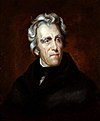John Forsyth (politician)
John Forsyth | |
|---|---|
Hugh Nelson | |
| 12th Attorney General of Georgia | |
| In office 1808–1811 | |
| Governor | Jared Irwin David Mitchell |
| Preceded by | John Hamil |
| Succeeded by | Alexander Allen |
| Personal details | |
| Born | October 22, 1780 Fredericksburg, Virginia, U.S. |
| Died | October 21, 1841 (aged 60) Washington, D.C., U.S. |
| Political party | Democratic-Republican (before 1825) Democratic (1825–1841) |
| Education | College of New Jersey (BA) (renamed Princeton) |
| Signature | |
John Forsyth Sr. (October 22, 1780 – October 21, 1841) was a 19th-century American politician from
33rd Governor of Georgia. As a supporter of the policies of President Andrew Jackson, Forsyth was appointed the 13th United States Secretary of State by Jackson in 1834, and continued in that role until 1841 during the presidency of Martin Van Buren
. He also served as US Minister to Spain during the presidency of James Monroe.
Early life
Forsyth was born in
John Forsyth, Jr.
, later became a newspaper editor.
Political life
Forsyth served in the
nullification. Forsyth was appointed as Secretary of State in reward for his efforts. He led the pro-removal reply to Theodore Frelinghuysen about the Indian Removal Act of 1830.[5][6] He supported slavery and was a slaveholder himself.[7]
Death and legacy
Forsyth died in Washington, D.C., and was buried in Congressional Cemetery. Forsyth County, Georgia,[8] Forsyth, Georgia,[9] and Forsyth Park[10] in Savannah are named for him.[11] He died the day before his 61st birthday.
In popular culture
- In the 1997 Amistad, Forsyth was played by character actor David Paymer.[12]
Notes
- ^ Brown, Russell K. (Fall 2008). "Killed in the Line of Duty: Marshal Robert Harriss, Jr., of Summerville, Georgia". Georgia Historical Quarterly. 92 (3). Retrieved October 25, 2016.
- ^ Whitmire, Kelly (January 25, 2019). "What's in a name? Historian talks about where road, area names originated in Cumming, Forsyth County". Forsyth News. Retrieved February 9, 2019.
- ISBN 9780306822650. Retrieved June 12, 2016.
- ISBN 9780195078947. Retrieved June 12, 2016.
- ISBN 978-0807150986.
- ^ Morris, Michael (Winter 2007). "Georgia and the Conversation over Indian Removal". Georgia Historical Quarterly. 91 (4). Retrieved October 25, 2016.
- ISBN 978-0821419342.
- ^ "Forsyth County historical marker". Digital Library of Georgia. Retrieved June 12, 2016.
- ^ "Forsyth historical marker". Digital Library of Georgia. Retrieved June 12, 2016.
- ^ "Forsyth Park historical marker". Digital Library of Georgia. Retrieved June 12, 2016.
- ^ Gannett, Henry (1905). The Origin of Certain Place Names in the United States. Govt. Print. Off. pp. 128.
- ^ "Amistad (1997)". Rotten Tomatoes. December 10, 1997. Retrieved May 13, 2018.
References
 This article incorporates public domain material from the Biographical Directory of the United States Congress
This article incorporates public domain material from the Biographical Directory of the United States Congress- Duckett, Alvin Laroy (1962). John Forsyth, political tactician. Athens: University of Georgia Press. ISBN 978-0820335346. Retrieved June 12, 2016.
External links
- United States Congress. "John Forsyth (id: F000284)". Biographical Directory of the United States Congress.
- John Forsyth at Find a Grave
- Biography at Players in the Amistad Affair
- [permanent dead link] Letter, 1825 Mar. 5, Washington, [D.C. to] G[eorge] M. Troup, [Governor of Georgia] / John Forsyth
- [permanent dead link] [Letter] 1826 June 15, Sand Hills, [Georgia] / John Forsyth
- [permanent dead link] [Letter] 1827 Dec 12, Milledgeville, Georgia, [to Governor] of Tennessee, Sam[ue]l Houston / John Forsyth, Gov[ernor of Georgia]
- [permanent dead link] [Letter] 1830 Jan 24, Georgetown, District of Columbia [to] George R. Gilmer, Governor of Georgia / John Forsyth







